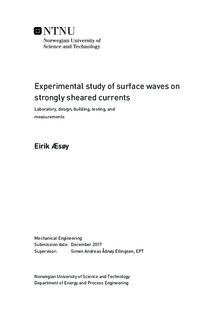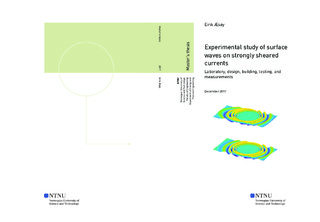| dc.description.abstract | In this thesis experimental methods to measure shear-dependent wave dispersion is implemented and used to study waves propagating on currents. To achieve such measurements one needs to establish the following measurement systems listed below, which is the objectives of this work.
1. Measure surface topology both in space and time.
2. Generate waves which can be controlled in space and time.
3. Measure velocities present in the flow.
4. Generate steady and uniform shear flow conditions.
Surface topology: Two optical methods for reconstructing the liquid surface topology are implemented, tested and used in case study experiments, where wave phenomenon has been measured and compared to theory.
Fourier Transform Profilometry (FTP):
FTP is shown to be an accurate method for measuring how a free liquid surface deforms in space and time by analyzing the deformation of an optical fringe pattern reflected on the free surface. An optical method to calibrate system parameters are designed, tested, and implemented and is shown to be an accurate calibration method. Using FTP on a liquid surface depends on diffuse reflection, hence color pigment has to be added, where titanium dioxide is chosen as the pigment. The relation between pigment concentration and image quality is studied together with the effect on wave damping properties. Dispersion of linear surface waves is measured and compared to linear wave theory, which shows good correlation between measured values and theoretical predictions showing that FTP captures the periodicity and time development of the surface topology.
Free Surface Synthetic Schlieren (FS-SS):
FS-SS is also shown to be an accurate method to reconstruct surface topology. FS-SS relates diffraction of a dot pattern to the surface gradient and is compatible with Particle Index Velocimetry (PIV), which also requires a transparent fluid, hence topology and velocity can be measured simultaneously. However, this method measures the surface gradient, hence the topology is reconstructed by a least square inversion technique implemented. Dispersion experiments do not require the surface topology since the dispersion of waves can be related directly to the specter of the gradient components, hence the inversion is not necessary for shear dispersion studies. The accuracy of the reconstruction surface gradient is measured through dispersion measurements performed on linear waves in quiescent waters, where the known linear dispersion relation is compared to measured values. Wave patterns (surface topology) are also demonstrated in a study where ring and ship wave patterns in quiescent waters are measured and compared to theoretical predictions, which quantitatively show good agreement with theoretical predictions.
Wave-makers:
To generate waves, two wave-maker mechanisms are implemented where spectrograms calculated from dispersion analysis shows agreement between generated waves and calculated wave spectrum from the measured surface topology. Wave-makers are used to generate waves used in experiments where dispersion data are used to calculate flow velocities and linear and nonlinear waves are studied and compared to theoretical predictions from wave theory.
Velocity measurements by Particle Image Velocimetry (PIV):
To measure the velocity field an LED powered PIV system is designed and implemented where image pairs of tracer particles are used to calculate the average flow velocities in the camera focus plane. Velocities are measured and compared to measurements from an inversion technique where the the an integral relation between dispersion data and the vertical structure of the velocity profile is inverted.
Wave-tank and shear flow generation: A centrifugal pump is circulating water between two tanks flowing over a flat transparent plate, where both PIV and FS-SS are installed to measure surface topology and velocities occurring in the wave-tank. The flow is directed through a combination of a curved mesh and straight honeycombs which generates a depth varying velocity profile, which is approximately linear.
Inversion technique for current profile reconstruction:
FS-SS, Wave-makers, and PIV are combined in a case study where space and time-averaged velocity profiles are measured both using PIV and shear affected dispersion data in an inversion algorithm, where the integral relation between wave-number dependent Doppler shifts and flow velocities are inverted to calculate the vertical structure of the current. Both methods show measurements in agreements with each other. | |

